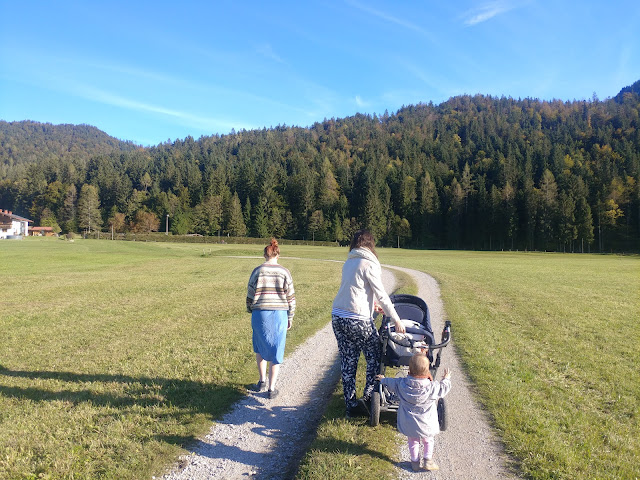Morning is Broken
 |
| Sunrise from my balcony at about 9 a.m. |
Word Prompt this Friday: Morning
Funny that this should be the topic for Five-Minute Friday this week. It so happens that Dan and I were just talking about sunrises. See, I recently moved up from a shaded downstairs room to my own little studio on the sunrise side of the third floor of our son's "Gast Haus" in southeastern Germany (Thank-you, guys! I love it!), and I had been bragging on the sunlight up here. Dan had cause to ask, given some of the beautiful places we've gotten to live, which sunrises I liked best: the beautiful Bavarian ones over Reit im Winkl (where I am now); the grand, Rocky Mountain ones near the San Juans in Western Colorado (where we lived some years ago); or the gentle little sunrises over our rolling hills and gardens at home in Iowa right now. My answer? I didn't even have to think about it! My hands-down favorite is the sunrise from my balcony here in Germany right now. Why, you ask? Not because it's more beautiful or more meaningful, but because the Gast Haus is so close to the foothills, the sun doesn't come up over the trees until about 9:00! 😊The first time I can honestly say I've truly enjoyed sunrises! No bleary-eyed cranky impression of the sun rising here!And there you have it. I'm not ashamed to say it: I am not a morning person. I chiefly get up for the coffee. I have to wait for the caffeine to start lubricating my brain in order to have enough function do decide if there's anything else worth having gotten up for. There's usually something, just in spite of the early hour, not because of it. Don't get me wrong, though; I do go through the motions: I'm a slug, but I get the morning things done. Sluggishly, but done. After prayers and my first cuppa and a quick scan of the news and mail, I get dressed, regardless of whether I'm going anywhere or not, I usually put on a little make-up and comb my hair. Unless I'm sick or the world is coming to an end, I make my bed and tidy things a bit. Don't be impressed by this -- these are all things that require no thought. There's no twittering around like a happy morning bird while I go about these chores. In fact, you really might want to just smile and wave when I pass. Or bring me coffee. (Ask my kids; big brownie points for this!)
On the flip side, I have to admit that I'm not a night person, either. You know those night owls who "wake up" around dinner time and then buzz around until the wee hours of the morning? Not me. Along about sundown, I'm thinking about bedtime. Not necessarily to go sleep, but to put up my sore feet (from hiking everywhere here in Germany, like they do, God bless 'em!). My usual plan is to read a book at this time. (Last night, though, I watched Hold that Ghost on my phone!) Regardless, I don't usually fall asleep before about 11 p.m or midnight. As you can see, I'm useless for anything meaningful after about 8 p.m., too, so everything that requires a brain and adrenals has to be accomplished between the hours of roughly 9 a.m. and 8 p.m., Iowa Standard Time -- which span of hours, in this part of the world, falls between 4 in the afternoon and 3 a.m. So, you can see, the overlapping conscious hours for Lisa fall between 4 p.m. and 9 p.m., German time. If you want brownie points for this end of the day, brink me a nice Cabernet. I'm an equal opportunity rewarder for both early bird and night owl brown nosers. (No, really. I would love one. Anybody out there in this zipcode...)And, so, here we are. What time is it? I have to keep an eye out, since this exercise is supposed to take me just five minutes. At this word, it is 6:20 p.m. in Reit im Winkl and I started writing at 6:16 -- but by the time I find some fun pictures and get this posted, it'll still be only around noon at home in the Midwest. If y'all didn't know better, you'd think I was tapping this out, bright-eyed and bushy-tailed, like a morning person, wouldn't you? But, HA! Nope. More like a mostly awake, but getting a little sleepy -- after dinner loiterer. Wishing someone would bring me that glassa.
Here's a thought, though: When I get back home to Iowa in December, my morning wake-up call (usually between 7 and 8 a.m.) will actually be between 2 and 3 p.m., body-time. 😮 Right? So much easier, jetlag-wise, going in that direction! Just might set me up to get those morning chores done bright-eyed and bushy-tailed! (😬 Or not.)
(For the record, ran over on the time -- by the time I went back and edited my typos -- and then a few more minutes to add memes and the photo! So, hmmm... I'm far from melancholic about this, just so y'all know!)
Run over to Five-minute Friday, Christian Writers Blog, to get in on the fun!



















































